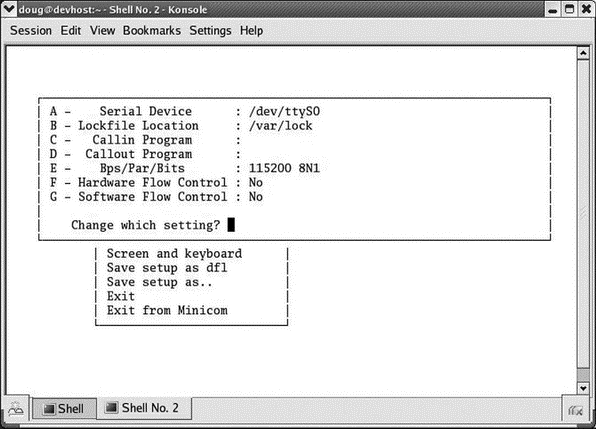Книга: Embedded Linux development using Eclipse
Configure Minicom
Configure Minicom
minicom is a fairly simple Linux application that emulates a dumb RS-232 terminal through a serial port. This is what we’ll use to communicate with the Linux system running on the target board.
There are a number of minicom configuration options that we need to change to facilitate communication with the target.
In a shell window as root user, enter the command minicom –s. If you’re running minicom for the first time you may see the following warning message:
WARNING: Configuration file not found. Using defaults
You will be presented with a configuration menu. Select Serial port setup (Figure 5.9). By default, minicom communicates through the modem device, /dev/modem. We need to change that to talk directly to one of the PC’s serial ports. Type “A” and replace the word “modem” with either “ttyS0” or “ttyS1”, where ttyS0 represents serial port COM1 and ttyS1 represents COM2. However, if your host only has USB ports and you’re using a USB-to-serial converter, the correct device is most likely “ttyUSB0.”

Figure 5.9: minicom serial port setup.
You’ll need to change the data rate (bps) to match your target board. Chances are you won’t want either hardware or software flow control.
Type Enter to exit Serial port setup and then select Modem and dialing. Here we want to delete the modem’s Init string and Reset string since they’re just in the way on a direct serial connection. Type “A” and backspace through the entire Init string. Type “B” and do the same to the Reset string.
Type Enter to exit Modem and dialing. In the Screen and keyboard menu, you may need to change the backspace behavior for shell line editing to work correctly. Finally, select Save setup as dfl to save the configuration.
You will probably have to change the permissions on the device node for the selected serial port to allow the group and world to read and write the device. And of course, you must be root user to do this.
- Configure Access Control
- Using DHCP to Configure Network Hosts
- Using Commands in the ftpaccess File to Configure wu-ftpd
- Configure User Information
- Configure System Logging
- Configure Permission Control
- Configure Commands Directed Toward the cdpath
- Using the autoconf Utility to Configure Code
- Using xconfig to Configure the Kernel
- Kernel Configured with IP Firewall
- The ipx_configure Command
- Configure mail routing for local hosts




